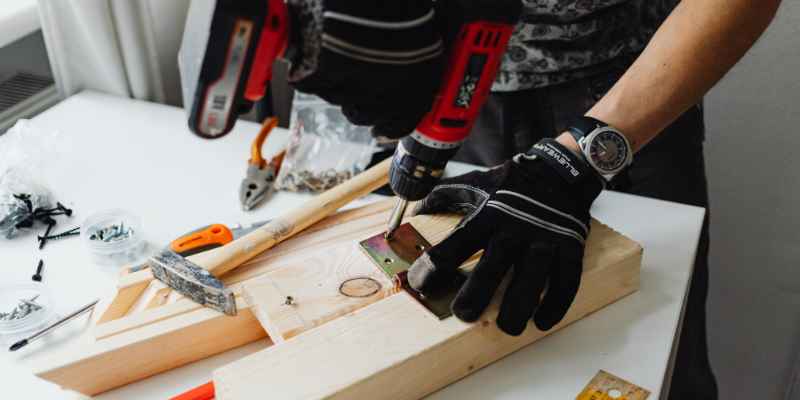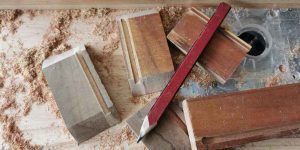To put a groove in wood, use a groove cutter with a shank or a disc groove cutter. A stop or template can be used to achieve a defined groove in the wood.
Cutting a groove in wood is a common technique used in woodworking projects. Whether you want to create a decorative detail or create a groove for a specific purpose, knowing how to do it accurately is important. Fortunately, there are various tools and methods available for putting a groove in wood.
We will explore different approaches and techniques to achieve precise grooves in wood. By following these steps, you can easily create professional-looking grooves in your woodworking projects.
Using A Groove Cutter With A Shank
To put a groove in wood, use a groove cutter with a shank along with a stop or template for a defined result. A disc groove cutter, like a lamella cutter, works well for straight or curved edges. Another option is to cut grooves in wood with a circular saw for woodworking projects.
What Tool Cuts Grooves Into Wood?
To cut grooves into wood, you will need a groove cutter with a shank. This tool is specifically designed to create precise and defined grooves in wooden surfaces. It is commonly used in woodworking projects to add decorative elements or create joints.
How Do You Make A Groove In A Piece Of Wood With A Groove Cutter?
To make a groove in a piece of wood using a groove cutter with a shank, you will need to follow these steps:
1. Prepare the wood: Ensure that the wood you are working with is clean, sanded, and free from any rough edges or imperfections.
2. Choose the right cutter: Select a groove cutter that is appropriate for the size and depth of the groove you want to create. Different cutters are available for various groove widths.
3. Mark the groove: Use a pencil or marking tool to draw a line on the wood where you want the groove to be. This will serve as a guide for the cutter.
4. Secure the wood: Clamp the wood down securely to prevent any movement while cutting the groove. This will ensure accuracy and prevent accidents.
5. Position the cutter: Attach the groove cutter to the shank of a router or drill machine. Make sure it is properly secured and aligned with the marked line.
6. Adjust the depth: Set the depth of the groove cutter according to your desired groove depth. This can be done by adjusting the router or drill machine’s depth control.
7. Cut the groove: Start the router or drill machine and carefully guide the groove cutter along the marked line, applying even pressure. Move the cutter in a smooth and controlled manner to create a clean and straight groove.
8. Check the groove: Once the groove is cut, inspect it to ensure it meets your desired specifications. Make any necessary adjustments or refinements as needed.
Tips For Using A Disc Groove Cutter
When using a disc groove cutter, it is important to keep the following tips in mind to ensure optimal results:
1. Select the right disc size: Choose a disc groove cutter that matches the size of the groove you want to create. Using a smaller or larger disc may result in uneven or inaccurate grooves.
2. Maintain a steady pace: When using a disc groove cutter, it is crucial to maintain a consistent pace. Moving too quickly or too slowly can affect the quality of the groove.
3. Use proper safety equipment: Always wear protective goggles, gloves, and a dust mask when operating a disc groove cutter. This will help prevent injuries and minimize exposure to harmful dust or debris.
4. Secure the wood: To avoid any movement or slipping, ensure that the wood is securely clamped in place before starting the cutting process. This will help maintain accuracy and prevent accidents.
5. Practice on scrap wood: If you are new to using a disc groove cutter, it may be beneficial to practice on a piece of scrap wood before working on your actual project. This will help you familiarize yourself with the tool and refine your technique.
Remember to refer to the manufacturer’s instructions and guidelines for specific information on using your particular disc groove cutter.
Cutting Grooves With A Router

To put a groove in wood, a router is a versatile tool that can be used. Grooves can be cut along the middle of the wood by using a router. Additionally, a groove cutter with a shank and a stop or template is essential for obtaining a defined groove.
Can You Use A Router To Cut A Groove In Wood?
Yes, a router is a versatile tool that can effectively cut grooves in wood with precision.
Different Router Bits For Cutting Grooves
- Straight bits
- Dovetail bits
- Rabbeting bits
Steps For Routing A Groove In Wood
- Secure the wood piece
- Select the appropriate router bit
- Adjust the router depth
- Run the router along the wood to cut the groove
- Repeat passes for desired groove width
Cutting Grooves With A Circular Saw
Cutting grooves in wood with a circular saw provides a simple yet effective method for creating clean, precise grooves for various woodworking projects. By following the right steps and using proper techniques, you can achieve professional-looking results without the need for a router.
How To Cut A Groove In Wood Without A Router
If you don’t have a router or prefer not to use one, cutting a groove with a circular saw is a viable alternative. While a circular saw may not provide the same level of precision as a router, it can still produce satisfactory results for many woodworking projects.
Steps For Cutting A Groove With A Circular Saw
When using a circular saw to cut a groove in wood, it is important to follow a structured approach to ensure accuracy and safety. Here are the steps to cut a groove with a circular saw:
- Place the wood on a stable surface and mark the boundaries of the groove.
- Set the depth of the saw blade to match the desired groove depth.
- Carefully cut along the marked lines, ensuring smooth and steady movements.
- After cutting the groove, use a chisel and hammer to refine the edges and remove any excess material for a clean finish.
- Finally, sand the groove to smoothen any rough edges and ensure a polished result.
Finishing The Groove
Once the groove is cut with the circular saw and refined with a chisel, sanding the groove to a smooth finish is essential. This step ensures that the groove is free from any rough edges and ready for further woodworking processes or finishing touches.
Cutting Grooves With Hand Tools
When it comes to woodworking, cutting grooves with hand tools is a fundamental skill that every woodworker should master. Utilizing hand tools such as chisels and marking knives allows for precision and control when creating grooves in wood. This method of cutting grooves is essential for creating joinery, decorative detailing, and various woodworking projects.
Alternative Methods For Cutting Grooves
When exploring woodworking techniques, there are various methods available for cutting grooves in wood. While power tools such as routers and table saws are commonly used, hand tools offer a more traditional and hands-on approach to cutting grooves. One of the primary hand tool methods for cutting grooves involves using a chisel and marking knife.
Using A Chisel And Marking Knife
Using a chisel and marking knife provides woodworkers with the ability to precisely outline and remove wood to form grooves. The marking knife is used to score the wood along the groove’s layout, creating a clean and accurate cut line. Once the groove is outlined, the chisel is carefully and methodically used to remove the wood within the scored lines, creating a precise and well-defined groove.
Cutting Grooves With Only A Saw And Chisel
An alternative method for cutting grooves with hand tools involves solely using a saw and chisel. This process begins by creating the initial outline of the groove using a saw, allowing for the removal of a majority of the wood within the groove’s dimensions. Subsequently, a chisel is utilized to refine and clean up the grooves’ edges, resulting in a well-crafted and smooth groove within the wood.
Using A Diy Grooving Plane
When it comes to adding decorative or functional details to your woodworking projects, creating grooves in wood can bring an interesting touch. One of the best tools you can use for this purpose is a DIY grooving plane. With a grooving plane, you can easily and precisely cut grooves in wood, giving your project a professional look. In this guide, we will walk you through the process of making and using a grooving plane, allowing you to achieve clean and precise grooves in your woodworking projects.
-
- Gather the necessary materials: To create your own DIY grooving plane, you will need a block of hardwood, a chisel, a hacksaw or coping saw, sandpaper, and a clamp.
- Shape the block of hardwood: Start by shaping the block of hardwood into a rectangular shape that fits comfortably in your hand. Use sandpaper to smooth the edges and ensure a comfortable grip.
- Mark the groove size: Determine the desired size of the groove and mark it on the top surface of the block. Measure and mark the depth of the groove as well.
- Create the groove guide: Use a chisel to create a shallow groove along the marked line. This groove will serve as a guide for the cutting blade.
- Prepare the wood: Choose a piece of wood for your project and mark the desired groove path with a pencil.
- Position the grooving plane: Place the grooving plane on the wood, aligning the blade with the marked groove path.
- Cut the groove: Apply gentle pressure to the grooving plane and push it forward, following the marked groove path. Repeat the process as needed until the desired groove is achieved.
- Inspect the groove: Once the groove is cut, inspect it for any rough edges or imperfections. Use sandpaper or a chisel to smooth and refine the groove if necessary.
By following these steps, you can effectively use a DIY grooving plane to create clean and precise grooves in wood. Remember to always exercise caution and work in a well-ventilated area. Happy woodworking!
Tips For Cutting Perfect Grooves
When it comes to adding decorative details or creating functional joints in wood projects, cutting a perfect groove is an essential skill to have as a woodworker. Whether you’re a beginner or an experienced craftsman, these tips will help you achieve clean, precise grooves every time. In this guide, we’ll explore three important aspects of cutting grooves: using a sacrificial board, setting the depth of the saw blade, and sanding and finishing the groove.
Using A Sacrificial Board
One effective technique for cutting grooves is to use a sacrificial board. This involves placing a scrap piece of wood underneath the workpiece to prevent tear-out and splintering on the bottom surface. The sacrificial board acts as a buffer, allowing the saw blade to cut cleanly through the wood without damaging the surrounding areas.
To use a sacrificial board, start by securing the workpiece and the sacrificial board firmly in place. Position the sacrificial board so that it aligns with the path of the saw blade. This way, when you make the groove cut, any tear-out or splintering will occur on the sacrificial board rather than the workpiece. Remember to always use a sharp blade to maintain clean cuts and minimize tear-out.
Setting The Depth Of The Saw Blade
Another crucial aspect of cutting perfect grooves is setting the depth of the saw blade correctly. The depth determines the width and depth of the groove, so it’s important to measure and adjust accordingly.
To set the depth, start by marking the desired depth on the side of the workpiece. Use a measuring tool or a depth gauge to ensure accuracy. Once marked, adjust the saw blade depth to match the measurement. It’s recommended to start with a shallower cut and gradually increase the depth until the desired groove is achieved. This prevents the risk of cutting too deep and compromising the integrity of the wood.
Sanding And Finishing The Groove
After cutting the groove, it’s essential to sand and finish it for a polished look. Start by using sandpaper or a sanding block to smooth out any rough edges or uneven surfaces. Begin with a coarse grit sandpaper and gradually move to finer grits for a smooth finish.
Once the groove is sanded, it’s time to apply a finish. Consider using a wood conditioner before applying the finish to promote even absorption and prevent blotching. Choose a suitable wood finish, such as stain or varnish, and apply it evenly to the groove using a brush or cloth. Allow the finish to dry completely before handling or further woodworking.
By following these tips for cutting perfect grooves, you’ll be able to enhance the aesthetic appeal and functionality of your wood projects. Remember to practice proper safety measures and use appropriate tools for each step, ensuring a satisfying and professional result. Happy woodworking!

Frequently Asked Questions Of How To Put A Groove In Wood
How Do You Make A Groove In A Piece Of Wood?
To make a groove in wood, use a groove cutter or circular saw with a guide. Place the wood on a sacrificial board, set the depth, and cut along the marked boundaries. Alternatively, you can use a chisel and hammer to create the groove manually.
What Tool Cuts Grooves Into Wood?
To cut grooves into wood, use a router to create precise and defined grooves on straight or curved surfaces.
How Do You Make Wood Grooves Without A Router?
You can make wood grooves without a router using a circular saw with a fence. Cut along the edges to establish the groove borders.
Can I Use A Router To Cut A Groove In Wood?
Yes, you can use a router to cut a groove in wood. A groove cutter with a shank is needed, and a stop or template can be used to achieve a defined groove. A disc groove cutter, such as a lamella cutter, is suitable for milling a groove on a straight or curved edge.
Conclusion
To sum up, cutting grooves in wood can be achieved using various tools like routers, circular saws, or even hand tools. Understanding the techniques and tools needed is essential for a successful outcome. Experimenting with different methods can enhance your woodworking skills and creativity.
Explore, practice, and enjoy woodworking!


